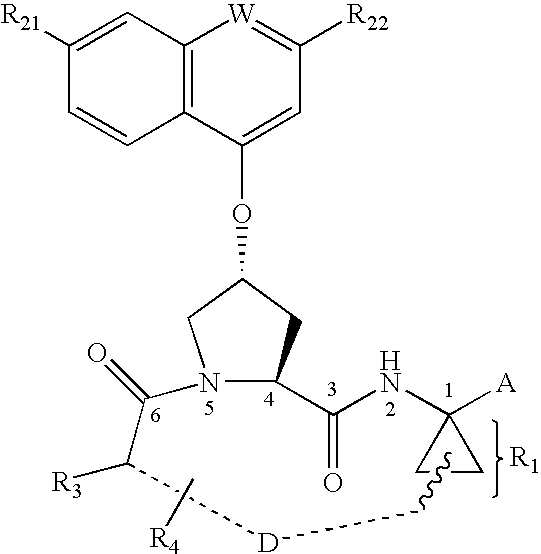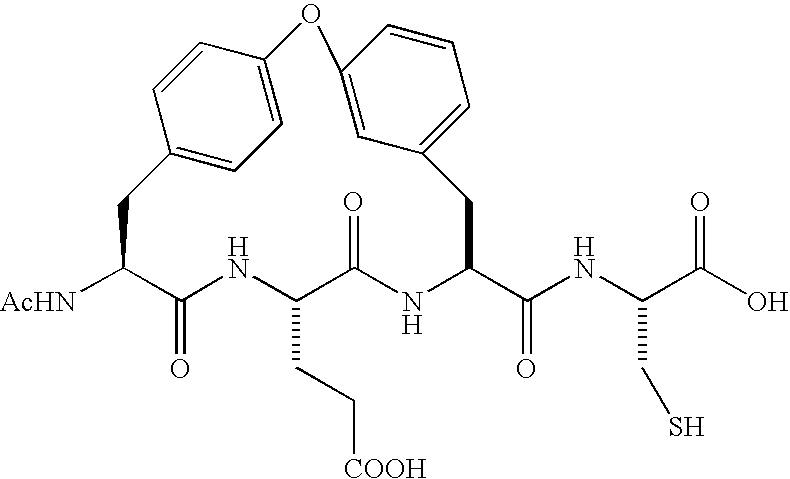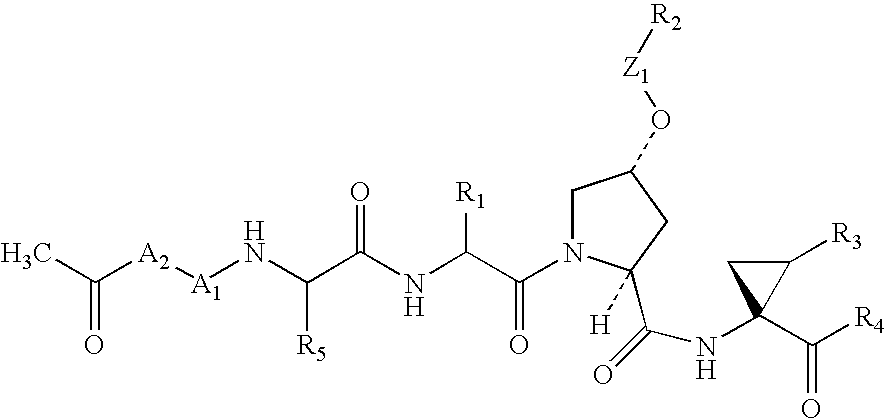3,4-(cyclopentyl)-fused proline compounds as inhibitors of hepatitis C virus NS3 serine protease
a technology of serine protease and cyclopentyl, which is applied in the direction of antiinfective drugs, peptides, drug compositions, etc., can solve the problems of low sustained response rate of therapies, frequent side effects, and poor treatment effect of patients with hcv infection
- Summary
- Abstract
- Description
- Claims
- Application Information
AI Technical Summary
Problems solved by technology
Method used
Image
Examples
examples
Synthesis of Intermediates:
Synthesis of Ethyl Ester 1a:
[0204]
The ethyl ester 1a was synthesized according to the procedure described by Monn and Valli (J. Org. Chem. 1994, 59, 2773-2778).
Synthesis of Intermediate 1:
[0205]
Sodium borohydride (924.5 mg) was added in small portions to a heterogeneous mixture of bicyclic ketone 1a in ethanol (50 mL) at 0° C. Reaction was stirred for 30 min. and TLC analysis (ethyl acetate / hexanes; 1:1) showed that all the starting material had been consumed. The reaction was quenched by the addition of AcOH (3 mL). The mixture was diluted with 250 mL of ethyl acetate and washed with aqueous saturated solution of sodium bicarbonate (2×50 mL) and brine (1×40 mL). The organic layer was dried over magnesium sulfate, filtered, and concentrated under reduced pressure. The residue was purified by column chromatography to afford the product in 92% yield.
[0206]
A solution of cyclopentanol 1b in 130 mL of dry tetrahydrofuran at 0° C. was treated with 1.08 g of 60% ...
example a
Preparative Example A
[0272]
[0273]A solution of acid 1 (255 mg) in 5 mL of dry dichloromethane and 5 mL of dry DMF was stirred at 0° C. and treated with HATU (368 mg). The amine hydrochloride 2 (201 mg) was added followed by addition of N-methylmorpholine (0.42 mL). The reaction mixture was gradually warmed to room temperature and stirred overnight. All the volatiles were removed under vacuum and the residue was taken into 100 mL of ethyl acetate. The organic layer was washed with aqueous 1 N HCl (15 mL), aqueous saturated NaHCO3 (15 mL), water (15 mL), brine (15 mL), dried over MgSO4, filtered, and concentrated under reduced pressure to afford the desired product A1. No further purification was carried out for the product.
[0274]
A solution of A1 (360 mg) in 20 mL of a 1:1 mixture of toluene / DMSO was treated with EDCl (1.3 g) and dichloroacetic acid (0.42 mL, d 1.563). Reaction mixture was stirred at room temperature for about 3 h. The reaction mixture was diluted with dichloromethane...
example b
Preparative Example B
[0277]
To a solution of the amine salt A3 in 1 mL of dry methylene chloride was added N-methylmorpholine (0.037 mL, d 0.920). The resulting solution was cooled in an ice-water bath and a solution of isocyanate 4 in toluene (0.64 mL of a 0.538M soln) was slowly added. The mixture was stirred for 2 h (temp 0 to 25° C.). The reaction mixture was diluted with 60 mL of dichloromethane and washed with 15 mL of aqueous 1 N HCl. Aqueous layer was back extracted with dichloromethane (2×20 mL). Combined organic layers were dried over magnesium sulfate, filtered and concentrated under reduced pressure. The residue was chromatographed on Silica gel (gradient: acetone / hexanes; 1:9 to 6:4) to give the product B (14.6 mg) as a white solid in 22% yield. HRMS (FAB) calcd for C31H50N5O6 [M+H] 588.3761; found 588.3757.
PUM
| Property | Measurement | Unit |
|---|---|---|
| temperature | aaaaa | aaaaa |
| temperature | aaaaa | aaaaa |
| temperature | aaaaa | aaaaa |
Abstract
Description
Claims
Application Information
 Login to View More
Login to View More - R&D
- Intellectual Property
- Life Sciences
- Materials
- Tech Scout
- Unparalleled Data Quality
- Higher Quality Content
- 60% Fewer Hallucinations
Browse by: Latest US Patents, China's latest patents, Technical Efficacy Thesaurus, Application Domain, Technology Topic, Popular Technical Reports.
© 2025 PatSnap. All rights reserved.Legal|Privacy policy|Modern Slavery Act Transparency Statement|Sitemap|About US| Contact US: help@patsnap.com



